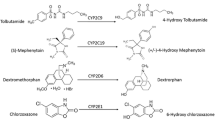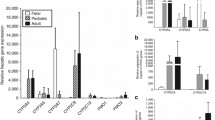Abstract.
Objective: To characterize the distribution of mathematically derived human hepatic CYP1A1 activity using differential inhibition of ethoxyresorufin O-deethylation (EROD) by fluvoxamine. Methods: Quantitative CYP1A1- and CYP1A2-mediated EROD activities were determined in 42 human livers using differential inhibition of EROD by fluvoxamine. CYP1A2-specific activity was also measured by phenacetin O-deethylation and caffeine 3-demethylation. Distributions of CYP1A1-mediated EROD and CYP1A2 probe activities were analyzed using cumulative distribution (probit) plots and the Kolgomorov-Smirnov test. Age effect on CYP1A1- and CYP1A2-mediated EROD activities was evaluated using descriptive statistics and analysis of variance. Results: The derived CYP1A1 protein concentration of 0.58±1.04 pmol/mg was only 4% of the derived CYP1A2. Since CYP1A1 is intrinsically far more active than CYP1A2 in mediating EROD, contribution of CYP1A1 to EROD represented approximately 25–40% of CYP1A2 contribution. Three of the 42 livers exhibited no CYP1A1-mediated EROD. Approximately 8% of the individuals showed high CYP1A1 activity phenotype based on cumulative distribution curve analysis. Hepatic CYP1A1 activity was more variable than that of CYP1A2. The variance of CYP1A1-mediated EROD was significantly different from that of CYP1A2, using the Kolgomorov-Smirnov statistical test. Even though not statistically significant, an age-related pattern in CYP1A1-mediated activity was identified: activity was high in the pre-puberty group, then decreased in the young/mature adult group and, finally, a slight increase was observed in old age. Conclusions: Distribution pattern in CYP1A1-mediated EROD suggests that the low derived CYP1A1 expression is most likely induced rather than constitutive. CYP1A1 activity deviates from log-normal distribution; the variations in hepatic CYP1A1 activity may affect the conversion of procarcinogens to carcinogens. The age-related trend in CYP1A1-mediated EROD activity hints that CYP1A1 responsiveness to inducers may change with age as well as with exposure to environmental inducers. These findings prompt (1) future genotyping studies to determine whether increased CYP1A1 inducibility is a result of genetic factors and (2) studies to address whether CYP1A1 inducibility changes with age.
Similar content being viewed by others
Author information
Authors and Affiliations
Additional information
Accepted in revised form: 23 May 2001
Electronic Publication
Rights and permissions
About this article
Cite this article
Sy, S.K., Tang, BK., Pastrakuljic, A. et al. Detailed characterization of experimentally derived human hepatic CYP1A1 activity and expression using differential inhibition of ethoxyresorufin O-deethylation by fluvoxamine. Eur J Clin Pharmacol 57, 377–386 (2001). https://doi.org/10.1007/s002280100330
Received:
Published:
Issue Date:
DOI: https://doi.org/10.1007/s002280100330




